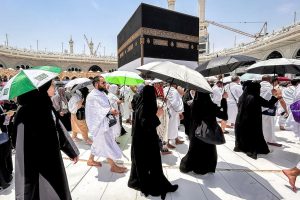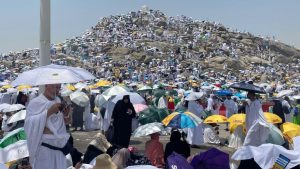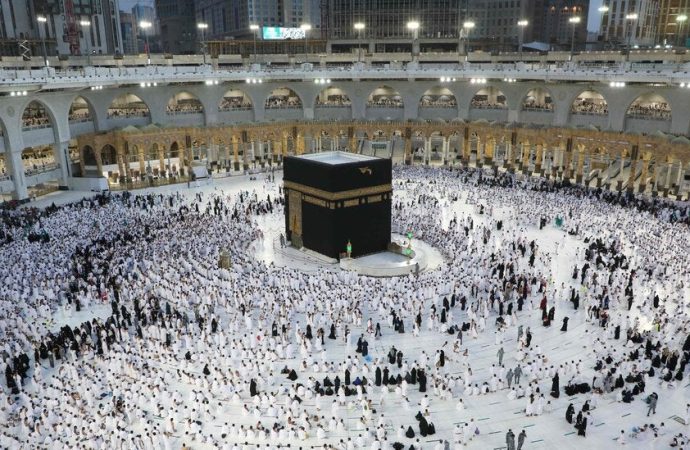Introduction Every year, millions of faithful Muslims embark on the Hajj pilgrimage—a profound spiritual journey to Mecca that unites the global Islamic community. In 2025, however, the sacred rite took a devastating turn. Over 1,300 pilgrims lost their lives to extreme heat, prompting urgent discussions on Hajj safety measures, pilgrim well‑being, and preparation for soaring
Introduction
Every year, millions of faithful Muslims embark on the Hajj pilgrimage—a profound spiritual journey to Mecca that unites the global Islamic community. In 2025, however, the sacred rite took a devastating turn. Over 1,300 pilgrims lost their lives to extreme heat, prompting urgent discussions on Hajj safety measures, pilgrim well‑being, and preparation for soaring temperatures. This tragedy shines a harsh light on the risks of Hajj 2025 heat and underscores why comprehensive planning and new protocols are more critical than ever.
The Significance of Hajj and Its Growing Scale

Image by: Yandex.com
Hajj is one of the five pillars of Islam, carried out during the Islamic month of Dhu al‑Hijjah. Its rituals—circling the Kaaba, standing on Arafat, and symbolic acts like the stoning of pillars—date back centuries. Every able Muslim must perform Hajj at least once in their lifetime, if able, making it both a personal obligation and a collective testament of faith.
In recent decades, annual pilgrim numbers have surged. Improved global travel and rising incomes in Muslim-majority countries have driven unprecedented growth, with 2.5 million pilgrims attending in 2022. This growth, while a sign of spiritual commitment, has placed immense pressure on Saudi Arabia’s infrastructure, resources, and emergency planning.
Scorching Temperatures and the 2025 Heatwave
July 2025 brought record-breaking temperatures to western Saudi Arabia. Thermometers soared above 50°C (122°F), far exceeding typical daytime highs. Such extreme heat is dangerous for any outdoor gathering, let alone one involving strenuous rituals, crowded accommodation, and long walks under the desert sun.
Factors contributing to heat‐related health risks include:
- Dehydration: High temperatures accelerate fluid loss, leading to dizziness, confusion, and organ failure if untreated.
- Heatstroke: Core body temperature above 40°C can cause permanent damage or death without immediate cooling and medical care.
- Overcrowding: Dense pilgrim gatherings limit airflow and shade, magnifying heat stress.
For many elderly and chronically ill pilgrims, these conditions proved fatal. Reports indicate that while over 1,300 lives were lost, countless others—perhaps ten times that number—suffered heat exhaustion or other serious complications.
Gaps in Current Safety Protocols
Despite Saudi Arabia’s substantial investment in Hajj infrastructure, several gaps emerged during the 2025 pilgrimage:
- Insufficient Shaded Spaces: Although temporary shelters and misting stations exist, they were overwhelmed by the sheer number of pilgrims. Many walking routes lacked continuous shade cover, leaving pilgrims exposed for hours.
- Water Access and Cooling Stations: Water distribution points could not keep pace with demand. Long queues left pilgrims waiting without hydration. Cooling stations—areas equipped with ice packs and medical tents—were too few and too far apart.
- Heat‑Aware Scheduling: Most Hajj rituals follow a fixed calendar. In 2025, critical events like the Day of Arafat fell under the sun’s peak. Without flexible scheduling or night‑time alternatives, pilgrims were forced into deadly heat.
- Emergency Response Delays: Overburdened ambulances and medical posts struggled to reach distressed pilgrims in time. Communication breakdowns between ground volunteers and central control exacerbated response times.
These shortcomings reveal that existing plans did not fully account for the escalating impact of climate change and extreme weather events on Hajj pilgrimages.
Learning from Other Mass Gatherings
Around the world, organizers of large events—such as marathons, music festivals, and sporting events—have adopted innovative heat‑risk strategies:
- Heat Action Plans: Cities like Phoenix and Dubai activate heat alerts, close high-risk areas, and offer cooling centers when temperatures exceed predefined thresholds.
- Dynamic Scheduling: Marathon start times shift to early morning or late evening to avoid midday heat.
- Digital Monitoring: Real‑time tracking of weather data and crowd density helps organizers deploy resources proactively.
- Volunteer Training: First‑aid volunteers receive specialized heat‑illness training and carry portable cooling kits.
Applying similar measures to Hajj could save lives without altering the pilgrimage’s spiritual essence.
Recommended Enhancements for Hajj Safety Measures
To protect pilgrim well‑being in future Hajj seasons, Saudi authorities and international partners should consider the following:
1. Expanded Shading and Cooling Infrastructure:
- Install retractable canopies and solar‑powered misting fans along all major pedestrian routes.
- Increase shaded rest areas equipped with seating, hydration stations, and first‑aid kits.
2. Hydration Support:
- Deploy mobile water‑distribution carts fitted with cold water and electrolyte solutions.
- Use wearable smart bracelets that alert wearers to hydrate based on heart rate and temperature sensors.
3. Flexible Ritual Scheduling:
- Introduce optional night‑time ritual slots, especially for high‑heat days.
- Employ digital ticketing with time‑stamped entry to spread pilgrim flow and prevent crowding during peak heat.
4. Advanced Medical Response:
- Position rapid‑response medical teams on motorbikes and in all‑terrain vehicles for quick access.
- Set up pop‑up medical tents with cooling beds and intravenous rehydration capability at frequent intervals.
5. Real‑Time Monitoring and Communication:
- Launch a mobile app with live weather alerts, crowd density maps, and nearest cooling station locations.
- Use SMS and loudspeaker announcements to advise pilgrims on heat conditions and preventive steps.
6. International Collaboration and Training:
- Partner with global health agencies to develop heat‑illness protocols and share best practices.
- Train volunteer groups from diverse countries in heat‑stroke recognition and rapid cooling techniques.
The Role of Pilgrims and Organizers

Image by: Yandex.com
While authorities bear the primary responsibility for infrastructure and emergency planning, pilgrims and their support teams also play a vital role:
- Personal Preparation: Pilgrims should undergo health screenings, receive advice on heat‑resistant clothing, and carry personal water flasks.
- Group Coordination: Travel groups must assign heat‑response roles—such as one member monitoring group hydration, another spotting warning signs of heat illness.
- On‑site Awareness: Pilgrims should familiarize themselves with the locations of medical tents, shaded rest areas, and information booths upon arrival.
By combining organizational improvements with personal responsibility, the Hajj community can make the pilgrimage safer for everyone.
Looking Ahead: Adapting to a Warming World
Climate change forecasts predict more frequent and severe heatwaves across the globe. Religious events like Hajj cannot remain static in the face of these trends. Embracing a proactive, adaptive approach will demonstrate that the sanctity of the pilgrimage and pilgrim well‑being are equally paramount.
Key steps include:
- Research and Innovation: Invest in studies on human performance in extreme heat and pilot next‑generation cooling technologies.
- Regular Drills: Conduct full‑scale emergency drills before each season to test new protocols and equipment.
- Feedback Loops: Gather post‑Hajj feedback from pilgrims and medical teams to refine strategies year after year.
As spiritual custodians of this ancient rite, Saudi authorities and the global Muslim community have a shared duty: preserving the sanctity of Hajj while safeguarding every pilgrim’s life and health.
Conclusion
The tragedy of the 2025 Hajj pilgrimage—where over 1,300 pilgrims succumbed to an unprecedented heatwave—serves as a stark reminder that tradition and safety must go hand in hand. By adopting comprehensive Hajj safety measures, expanding cooling infrastructure, and leveraging modern technology, we can honor the spiritual essence of the pilgrimage without risking lives. Pilgrims deserve not just the chance to fulfill a sacred obligation, but to return home safely, their faith enriched rather than cut short. It is time for a unified global effort to ensure that every future Hajj stands as both a testament of devotion and a model of effective heat‑risk management.
















